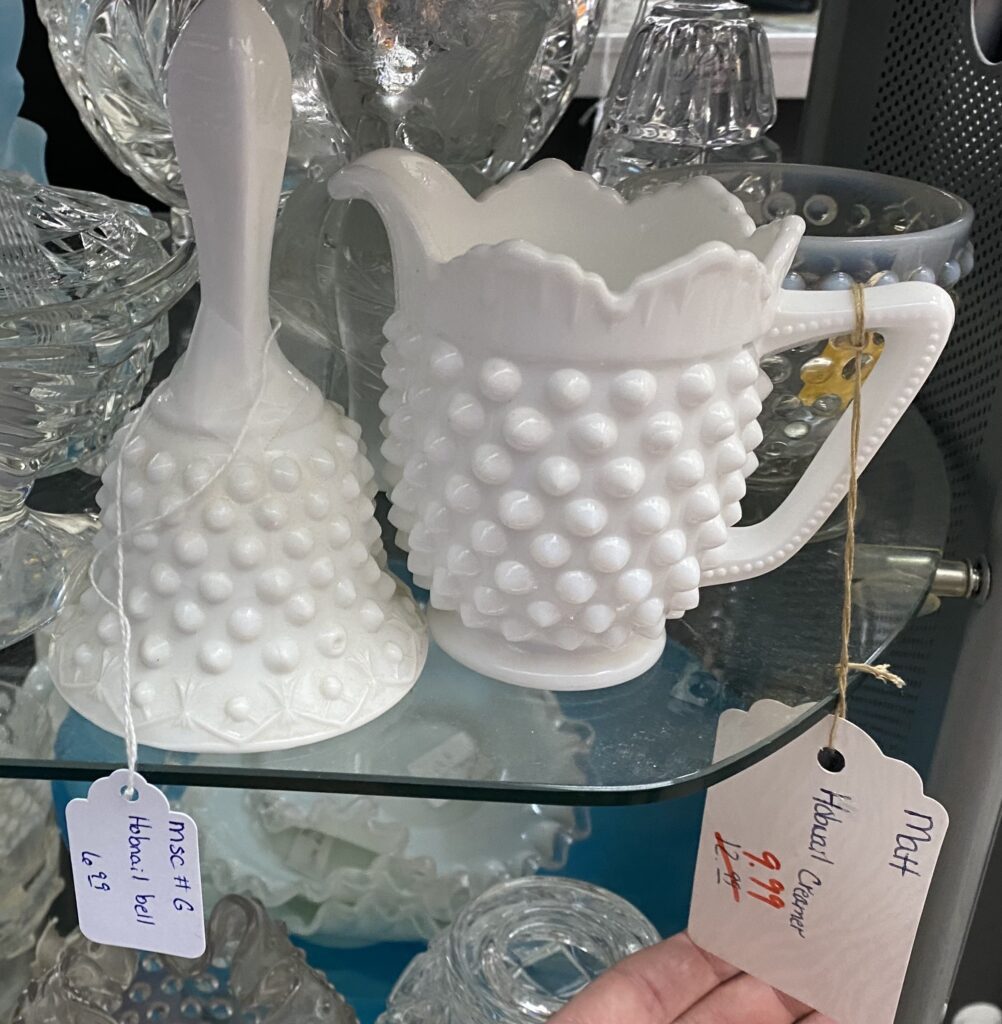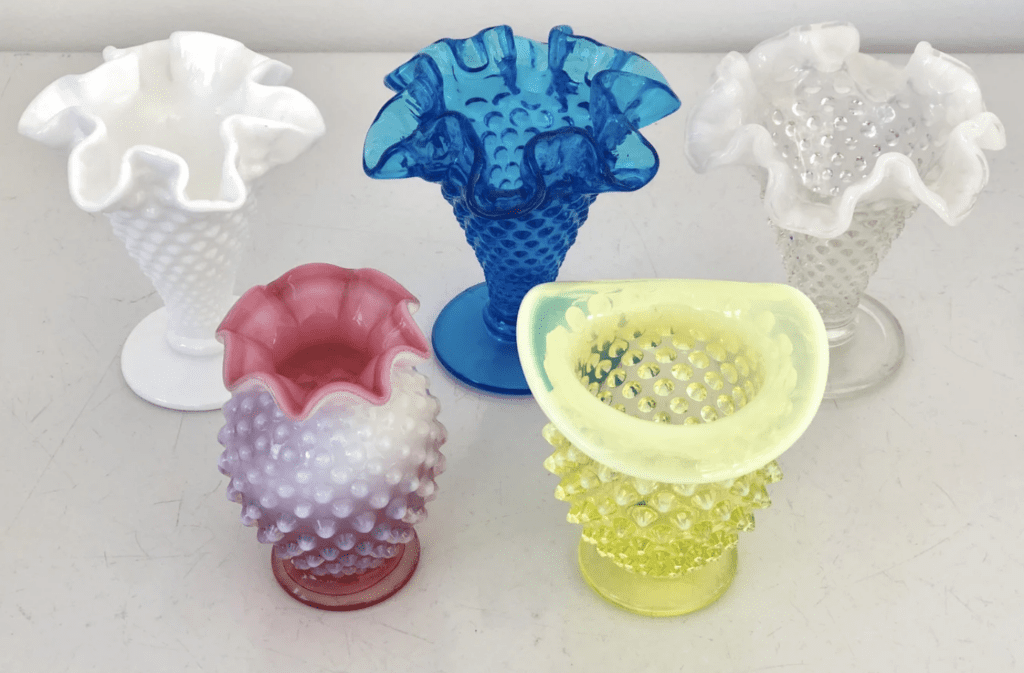Hobnail glass is a common type of collectable antique glassware. It has distinctive a distinctive “knob” pattern and comes in a variety of colors. You’ve likely seen this glassware at yard sales, estate sales, and antiques stores as it is frequently found.
The term hobnail originates from the hobnail stud pattern used on some boot soles. Most popular during Victorian times, this type of glass was created by blowing glass into a mold or pressing glass into a mold. Hobnail glass can be found in a variety of translucent colors as well as an opaque, milk-white color.
If you’re looking for a particularly interesting piece with a fascinating history to add to your collection, you’ll want to learn more about hobnail glass by reading this post. We’ll discuss the complex history of hobnail glass, common manufacturers, and other resources to review where you can learn more about hobnail glass.

History of Hobnail Glassware
Hobnail glass was created during the Victorian era and was also known as “dew drop glass”. The glass was made by pressing it into a mold, then using a hand-blowing technique to mold the piece into its final shape. Information about who created hobnail glass is a bit murky. Some sources claim that hobnail glass was first created by an artist at Hobbs Brockunier and Company, located in West Virginia, in 1886.
However, other sources cite A. J. Beatty and Sons as being the first producers as far back as 1850. At this time, dew drop glass was made in translucent shades of various colors. You may come across many online resources that cite Fenton as the original creators of hobnail glass, but this is not so. While Fenton produced the vast majority of pieces that are found today, they are not the original creators of hobnail glass, and we may never 1005 know for sure who can claim to be the first producer of hobnail glass.
West Virginia glassmaker Fenton began producing hobnail glass in 1939 also in translucent shades. One of their most popular shades in the translucent color scheme was cranberry opalescent, manufactured from 1956 to 1989. In the mid-20th century, began producing milk glass with a hobnail pattern. After 1958, Fenton milk glass was more opaque and is their most known product. If you see a Fenton milk glass piece in your search for collectable glass, it will likely be post-1958.
Is Hobnail the Same as Milk Glass?
No, hobnail glass is not the same as milk glass. While milk glass can be found with a hobnail pattern, hobnail glass is not exclusively manufactured in a milky shade.
Hobnail glass can be found in a variety of shades and transparencies. However, you’ll likely be most accustomed to seeing hobnail glass in a milky opaque shade as Fenton produced a vast amount of hobnail pieces in milk glass and made that type of hobnail glass extremely popular.

Milk glass can be found in a variety of patterns and styles, not just with a hobnail pattern. In addition, the milk glass name can be a bit misleading: milk glass refers to its opaqueness, not coloring. Milk glass can be found in a variety of colors, but white is definitely the most commonly found shade.
What Glass Companies Made Hobnail Glass?
Fenton pieces seem to be the most popular and easiest to find when searching for collectable hobnail glass. But Fenton was not the only company to make hobnail glass pieces.

Other manufacturers of hobnail glass include Westmoreland Glass, Kemple Glass, Duncan and Miller, Anchor Hocking, various British companies, and in recent years it is imported from China and Taiwan as well. And of course, hobnail glass can be found from the Hobbs Brockunier Company which was the first manufacturer of hobnail glass.
Another company named Jeannette Glass Company briefly produced hobnail glass in the 1950’s. They created a tableware pattern that had small hobnails alternated with panels of clear glass. This list is not exhaustive as many companies that have come and gone over the years have produced hobnail glass.
When was Hobnail Glass Popular?
Hobnail glass was extremely popular during the Victorian era and was typically hand-blown instead of pressed into a mold, although some pieces were mold-pressed during that time. It had a resurgence in popularity in the mid-20th century when Fenton began producing milk glass with a hobnail pattern. But one could argue that hobnail glass has never really been unpopular, as it has been highly collectable over the years and sought after even today.
How Old is Hobnail Glass?
Hobnail glass dates to Victorian times, which means it’s been around for nearly 200 years. However, most pieces you’ll find are likely the Fenton produced ones from the 1950’s and onward. Also, hobnail glass is still being produced today. It is safe to say that hobnail glass has been with us for at least two centuries, making it a treasured part of the rich history of collectable glass.
What era is hobnail glass from?
Hobnail glass is originally from the Victorian Era but was also popular during the mid-20th century since Fenton produced a vast number of hobnail pieces. During the 1950’s-1960’s when hobnail glass became popular again, hobnail milk glass could be found in many forms including table lamps, ashtrays, vases, candleholders, and various kitchenware items. Fenton also produced milk glass in a variety of colors other than the most commonly spotted white shade.
More Information on Hobnail Glass
For more information about specific types of hobnail glass as well as its history, get a copy of these books from your local library or online. Please keep in mind that books will not have the most up-to-date pricing information, so use these resources for information and historical purposes only.
Florence C. G. & Florence G. (2010). Collectible glassware from the 40s 50s 60s– : an illustrated value guide (10th ed.). Collector Books.
Griffith S. (1994). A pictorial review of fenton’s white hobnail milk glass : a collector’s guide with price valuation (Rev.). author.
Kovar L. (2004). Westmoreland glass : the popular years 1940-1985 : identification & value guide. Collector Books.
Lee R. W. (1946). Early american pressed glass. a classification of patterns collectible in sets together with individual pieces for table decorations (Enl. and rev). author.
Whitmyer M. & Whitmyer K. (2006). Fenton art glass hobnail pattern : identification & value guide. Collector Books.
Whitmyer M. & Whitmyer K. (2007). Fenton art glass patterns 1939-1980 : identification & value guide (2nd ed. values updated). Collector Books.
https://www.glassencyclopedia.com/hobnailglass.html
https://www.glassencyclopedia.com/dewdropglass.html
https://en.wikipedia.org/wiki/Fenton_Art_Glass_Company
https://vintageunscripted.com/2022/05/06/a-vintage-classic-hobnail-glass/


